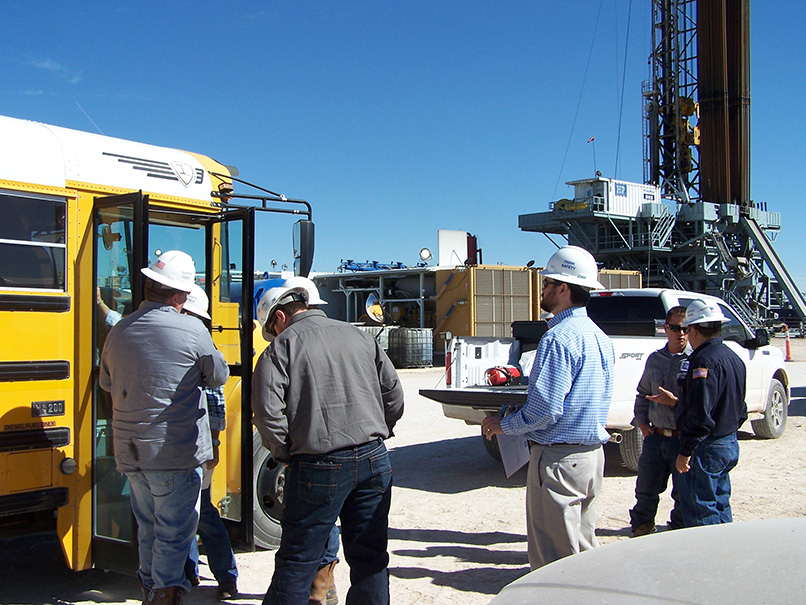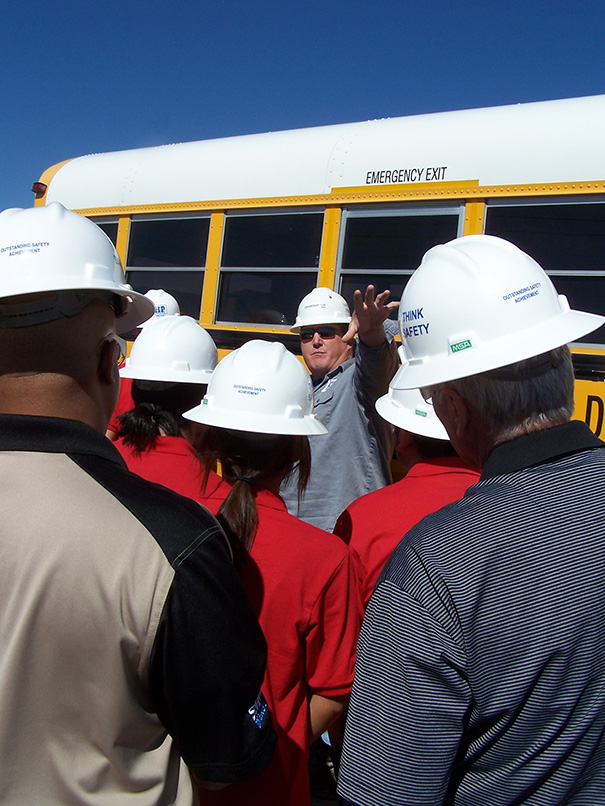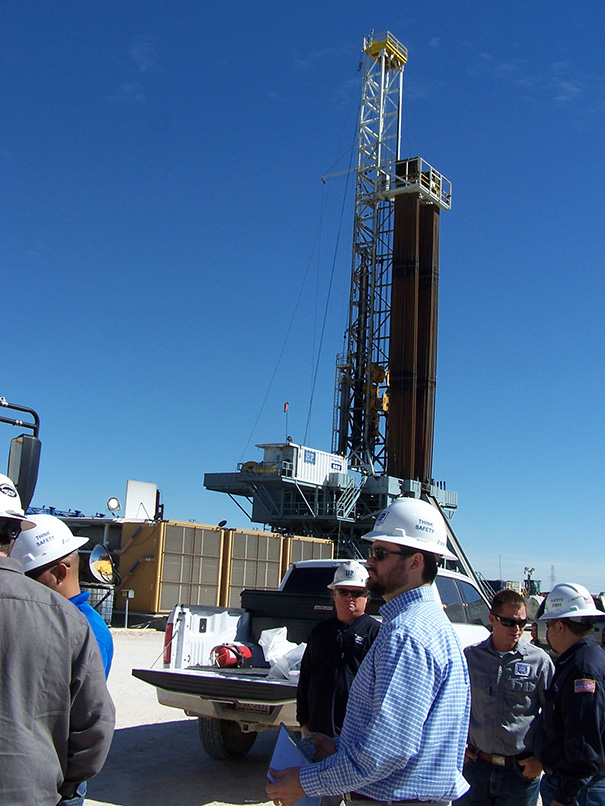MISD’s Petroleum Academy visits a Diamondback rig north of Midland. The Permian Basin Petroleum Association and the E&P firm Diamondback among those contributing to training the next generation of oilfield hands.
by Paul Wiseman
The phrase “field trip” may conjure up images of the zoo or the farm. But for enrollees in the Midland Independent School District’s Petroleum Academy, a trip to the oil field is more appropriate.
On Sept. 29, 11 Petroleum Academy students from Midland High and Midland Lee traveled out to a Diamondback Energy drill site north of Midland to see and hear firsthand what happens in the process of drilling a horizontal well. The students, along with three Petroleum Academy instructors, and a team of MISD leaders, were toured around the rig by Diamondback technicians, learning about all aspects of rig activity. All participating students were 11th graders who had been safety certified.
Petroleum Academy Coordinator Anthony Frost said it all started about three years ago as a result of the vision of some MISD administrators and industry leaders. They convened the first classes in 2015.
“The program has two focuses,” said Frost. “First, it’s geared for college-bound STEM [science, technology, engineering, and math] students” who are likely to major in a petroleum-related subject. While there are many factors involved in college acceptance, Frost feels this program could contribute to students getting into their preferred university program.
Second, there is a career-ready option in which students can apply for certain jobs right out of high school. The Petroleum Academy program can also dovetail with Midland College certifications such as those for auto mechanics, welding, and others. Students go through a program that gives them safety certification, which can apply to a number of industries.
Frost said this certification has already shown itself to be beneficial, citing one student who got a current job at a fast food restaurant because of it. Frost observed that slick floors, hot surfaces, and a sometimes-frantic pace at such locations makes safety training a true asset.
An MISD FAQ page online indicates a goal of 100-120 students in both the Midland High and Lee High feeder systems. Students can begin applying in eighth grade, with the program beginning sophomore year.
Because it is a complete program, everyone must start at the beginning. Last year, the program’s first, MISD took only a sophomore class. For the 2016-2017 school year MISD took on another sophomore class while the first students moved on to their junior year. All students at the well site were juniors who started in the program last year.
Frost said the program has been welcomed by the industry, with many companies such as Diamondback having provided students with equipment like hard hats, safety glasses, and more, along with t-shirts. They’ve brought in speakers as well as hosting the occasional field trip.
“One of the most important aspects of this program is the opportunity for the student to meet and hear from people who work in the field they’re studying,” said Frost.
With a number of family members in the oil business, Midland High Junior Marissa Alarcon has always been interested in it. She said she “hopped on” to the program as soon as she heard about it. Her long-term goal is to earn a degree in geology, but she’s still considering which college to attend.
MISD instructor Laurence Smith, who teaches the second-year Oil and Gas II class, joined the program after having been a football coach. Before that he spent three years in the oil field. “This is a wonderful program. Here the kids can learn a lot of things that I had to learn the hard way, on the job,” he said.
Frost added that the program does indeed allow students to observe much of the industry’s machinery in action in order to better learn how it works.
So many students graduate high school without any idea of what they want to do next, said Frost. The overall goal of this program is to “encourage our kids to have a dream and to start working toward that dream now. We can help them achieve their goals.”
Diamondback Energy is excited to be part of the Petroleum Academy program for similar reasons. Adam Lawlis, Diamondbacks’ manager of investor relations, says the company sees this as a way to support the community. “Our CEO, Travis Stice, is very committed to education,” said Lawlis, “and was looking for a way to get involved in this program.” Lawlis noted that Stice himself is a third-generation Midlander, a graduate of Midland Lee, so he was pleased to be able to contribute.
“We think this program is great—we’re fully behind it,” Lawlis continued, stating that Diamondback has hired a good number of MISD graduates in general. He hopes that the new program, by training hometown students, will create “sticky” employees who will stay with the company long term because they did not move to Midland from elsewhere.
Diamondback did not want to limit its involvement to writing a check. “We were looking for ways to contribute some sweat equity to this—a way to leverage our expertise to the benefit of the students,” said Lawlis.
This particular site exposed the students to the latest technology. The rig on site is a walking rig manufactured by Helmerich and Payne. Its ability to “walk” to a nearby site after finishing one well means it can move in one day instead of three. This, along with its ability to drill a well in 12 days instead of the 20 needed by older rigs, saves producers tens of thousands of dollars, making it and rigs like it the wave of the future and one that students may see more of after they graduate.
PBPA Executive Vice President Stephen M. Robertson says that organization is involved because many of its members are—and that education is the key reason.
“Part of our mission at the PBPA is to educate our members and the public about the oil and natural gas industry,” he explained. “While some might think that education from a trade association only involves legislative or regulatory issues, we don’t feel that way. The lifeblood of Midland and most of the other communities in the Permian Basin is the oil and gas industry. It is essential that the future workforce of the Permian Basin not only understand why the oil and gas industry is important to their daily lives, but also what opportunities await them in this industry to not only make a living, but to create a great life. The MISD Petroleum Academy is a wonderful platform to provide this type of education.”
Robertson sees a bright future for the program, noting that “it will continue to need support from the community to be successful. Providing two tracks for those involved, one track for students who plan on continuing their formal education after high school, and another track for students looking to enter the workforce after high school, shows a great understanding of the realities of life after graduation. I’d love to see the program continue to grow in student participation to the point where it not only becomes a staple of MISD, but a standard by which other similar programs compare themselves.”
Just as the Permian Basin is the heart of oil production in the United States, it would be great if it were also the heart of industry training and education, he said.
Paul Wiseman is a freelance writer in Midland.













